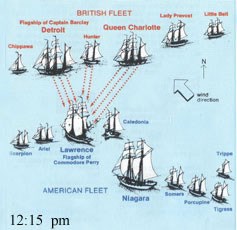|
At 11:45 a.m. the Detroit fired the first shot at extreme range, a 24-pounder that splashed harmlessly near the Lawrence. A few minutes later a second 24-pounder was fired, but this time the heavy ball punched through the bulwarks of the Lawrence and flying splinters killed and wounded American sailors. The Lawrence's carronades were still far out of range, so Perry issued orders to the Scorpion, with one long 24-pounder, and the Ariel, with four long 12-pounders, to open fire. For the next thirty minutes Perry struggled to close within range, during which time the Lawrence was forced to pass almost the entire British battle line, suffering punishment all the way. Another problem for Perry was the small gunboats bringing up the rear of his battle line. Because the wind was light the little schooners and sloop fell behind early, and even with all sail set and sweeps working, when the battle opened they were still two miles astern and temporarily out of the fray. 
NPS Photo Elliott's actions were somewhat justified initially. The Caledonia, directly ahead of the Niagara, also shortened sail. The Caledonia's commander, facing the Queen Charlotte's vastly superior broadside, wisely decided to stand off and not futilely jeopardize his vessel. Since one of Elliott's two procedural directives dictated that he maintain his position in line, Perry's second-in-command was simply following his superior's orders. Elliott opened with the Niagara's 12-pounder bow chaser, which in his current position astern of the Caledonia was the only gun able to bear. As the battle progressed the Caledonia continued to hesitate, so Elliott decided to range in front of the smaller brig. The Niagara's captain displayed initiative by abandoning the rigid line-of-battle tactic, justifiably disregarding one of his superior's orders. Having made his move Elliott could now follow Perry's second specific order, to engage his designated adversary at close range - the Niagara's pre-ordained opponent was the Queen Charlotte. But instead of closing with the British line Elliott eased the Niagara to windward, angling slightly away from the enemy ships. The reason for Elliott's questionable movement is still being debated, but regardless of motive the Niagara's carronades, almost forty percent of Perry's total broadside strength, sat indolently out of range. With the Niagara lingering to windward the Queen Charlotte's guns were rendered useless. The commander of the second largest British vessel, possibly not understanding his adversary's move but anxious to bring his guns to bear, allowed his vessel to pay off and glide forward of the General Hunter, where she could assist the Detroit against the Lawrence. Practically ignoring the smaller American support vessels, the Detroit, Queen Charlotte, and General Hunter focused their broadsides, pounding the Lawrence while the Niagara remained a spectator. Fighting desperately the American flagship inflicted considerable damage upon the British, but the Lawrence was overwhelmed by superior firepower. page 1. page 3. |
Last updated: April 10, 2015
